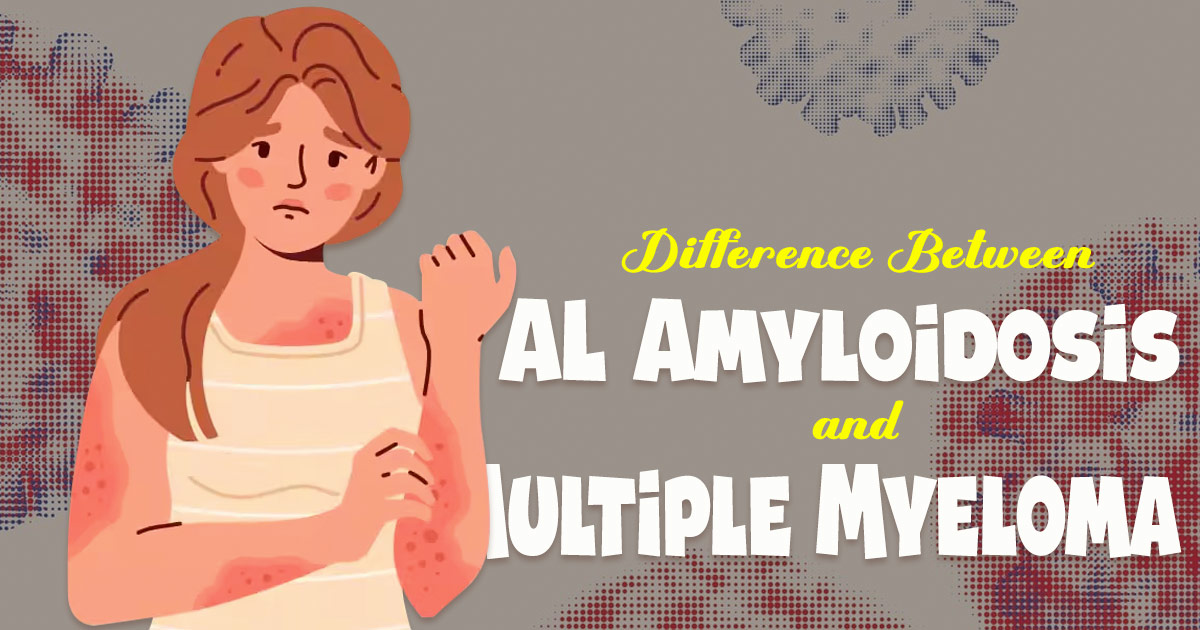What’s the Difference Between AL Amyloidosis and Multiple Myeloma?

When it comes to rare diseases, AL amyloidosis and multiple myeloma often confuse people because of their connections—but they’re not the same thing. Both involve trouble with plasma cells in the bone marrow, but they affect the body differently. Did you know about 36,110 new cases are expected to be diagnosed with multiple myeloma in the U.S. this year? Meanwhile, AL amyloidosis is even rarer, affecting thousands of people annually.
If you’ve heard these terms (or are dealing with a diagnosis), it can feel overwhelming. Don’t worry—we’ll unravel it all down for you.
AL Amyloidosis vs Multiple Myeloma: What Links Them Together?
AL amyloidosis and multiple myeloma both start with plasma cells. These are important immune cells that usually make antibodies to help fight infection. But when something goes wrong, plasma cells become abnormal and create significant health issues.
- Multiple Myeloma happens when plasma cells grow uncontrollably. This leads to tumors in the bone marrow, causing issues like weak bones, kidney problems, and fatigue.
- AL Amyloidosis, however, isn’t about growth. Instead, the plasma cells produce abnormal proteins (light chains). These proteins cluster together as amyloid deposits, which can damage organs like the heart, kidneys, or liver.
One common question is, “Is light chain amyloidosis a cancer?” The answer is no. AL amyloidosis isn’t classified as cancer, but because it stems from plasma cell trouble, it’s closely tied to multiple myeloma. Around 10–15% of people with multiple myeloma eventually develop amyloidosis during their disease.
How Do the Symptoms Compare?
Since both conditions mess with plasma cells, they can sometimes cause similar symptoms, but there are key differences.
Multiple Myeloma Symptoms
These tend to focus on the bones and blood. You might notice things like:
- Bone pain or fractures (often in the ribs or spine)
- Fatigue, because of low red blood cells (anemia)
- High calcium levels, leading to thirst, confusion, or nausea
- Kidney problems from the abnormal proteins
- A weak immune system with frequent infections
AL Amyloidosis Symptoms
AL amyloidosis symptoms depend on which organs are impacted. Here’s what to watch for:
- Heart issues: Shortness of breath, irregular heartbeat, or swelling from heart failure.
- Kidneys: Swelling in the legs or protein in the urine.
- Liver and spleen: A feeling of fullness or discomfort under your ribs.
- Nerves: Numbness or tingling in your hands and feet.
- Other signs: An enlarged tongue, easy bruising, or mysterious black-and-blue marks around the eyes (raccoon eyes).
Unlike multiple myeloma, AL amyloidosis doesn’t cause bone damage because it’s focused on organ health.
Getting Diagnosed
Diagnosing these conditions isn’t always straightforward. Since their symptoms overlap with other illnesses, many people face delays in receiving the right diagnosis.
For Multiple Myeloma
Doctors typically start with blood tests to check for:
- Abnormal proteins (M-protein)
- Kidney problems (creatinine levels)
- High calcium or low blood counts
Bone x-rays, MRIs, or PET scans help identify bone damage, while a bone marrow biopsy confirms the presence of too many plasma cells.
For AL Amyloidosis
Doctors focus on detecting amyloid deposits, often using:
- Tissue biopsies (from the fat of your belly, kidneys, or heart)
- Blood tests like free light chain analysis to track abnormal proteins
- Heart imaging (echocardiograms or MRIs) if there’s suspected heart involvement
If you already have multiple myeloma, it’s worth asking your doctor about testing for amyloidosis, especially if there are signs of organ damage.
What Are the Treatment Options?
Because these diseases both involve faulty plasma cells, the treatments are often similar. However, AL amyloidosis patients need more personalized care, particularly if their organs are struggling.
Multiple Myeloma
Treatment focuses on stopping the growth of cancerous plasma cells. Common approaches include:
- Chemotherapy and targeted drugs to destroy cancer cells
- Immunotherapy to help your immune system fight back
- Stem Cell Transplants (SCT): High doses of chemotherapy followed by replacing bone marrow stem cells for eligible patients
- Bone-strengthening meds like bisphosphonates or radiation for stubborn bone problems
AL Amyloidosis
The main goal in AL amyloidosis is to stop the production of toxic light chains before they cause more damage. Options include:
- Daratumumab-based treatments: A mix of chemotherapy drugs (cyclophosphamide, bortezomib, dexamethasone) combined with immunotherapy.
- Stem cell transplants may work for some patients, but only about 20% qualify due to organ fragility.
There’s still no widely approved way to remove existing amyloid deposits, but clinical trials for new drugs bring hope.
What About Life Expectancy?
The outlook varies for both diseases, depending on how early they’re caught and how severe they are.
- Multiple Myeloma Life Expectancy: On average, about 57% of patients live five or more years after diagnosis, thanks to treatment advancements. Younger patients or those caught early often do even better.
- AL Amyloidosis Life Expectancy: This depends mostly on how much heart damage the disease causes. Without heart involvement, patients can live much longer, especially with proper treatment. However, severe heart issues may shorten survival to months without aggressive intervention.
Finding Hope Amid Uncertainty
Living with AL amyloidosis or multiple myeloma can be overwhelming, but understanding these conditions is the first step toward managing them effectively. On a personal note, if I’ve learned anything from these diseases, it’s that early detection and proactive care are life-changing.
If you or someone you know is dealing with multiple myeloma with amyloidosis, don’t hesitate to explore clinical trials, build a strong support team of healthcare providers and loved ones, and stay informed about new treatments. Research is advancing rapidly, and with it, hope for better outcomes is growing.
